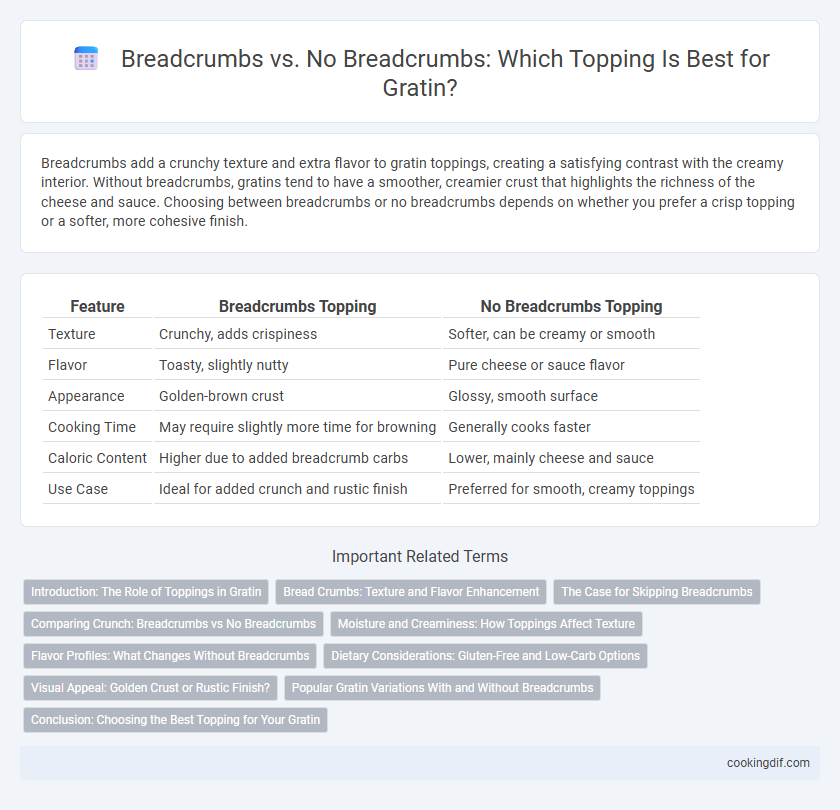Breadcrumbs add a crunchy texture and extra flavor to gratin toppings, creating a satisfying contrast with the creamy interior. Without breadcrumbs, gratins tend to have a smoother, creamier crust that highlights the richness of the cheese and sauce. Choosing between breadcrumbs or no breadcrumbs depends on whether you prefer a crisp topping or a softer, more cohesive finish.
Table of Comparison
| Feature | Breadcrumbs Topping | No Breadcrumbs Topping |
|---|---|---|
| Texture | Crunchy, adds crispiness | Softer, can be creamy or smooth |
| Flavor | Toasty, slightly nutty | Pure cheese or sauce flavor |
| Appearance | Golden-brown crust | Glossy, smooth surface |
| Cooking Time | May require slightly more time for browning | Generally cooks faster |
| Caloric Content | Higher due to added breadcrumb carbs | Lower, mainly cheese and sauce |
| Use Case | Ideal for added crunch and rustic finish | Preferred for smooth, creamy toppings |
Introduction: The Role of Toppings in Gratin
Toppings play a crucial role in gratin by adding texture and enhancing flavor complexity. Breadcrumbs create a crispy, golden crust that contrasts with the creamy interior, while opting out of breadcrumbs results in a smoother, more uniform surface. The choice of topping directly influences the gratin's mouthfeel and visual appeal, shaping the overall dining experience.
Bread Crumbs: Texture and Flavor Enhancement
Breadcrumbs provide a crispy, golden crust that enhances both texture and flavor in gratins by adding a satisfying crunch contrasting with the creamy interior. Their ability to absorb butter or oil and toast evenly creates a rich, nutty aroma that elevates the overall dish. Using breadcrumbs as a topping ensures a visually appealing finish and a multidimensional taste experience that plain gratin lacks.
The Case for Skipping Breadcrumbs
Skipping breadcrumbs as a gratin topping enhances the dish's natural creaminess and allows rich, melted cheese and sauce to shine without distraction. Breadcrumbs can sometimes overpower subtle flavors and add unnecessary dryness, detracting from the gratin's cohesive texture. Opting out of breadcrumbs results in a smoother, more luxurious finish that highlights the fresh ingredients and creamy consistency.
Comparing Crunch: Breadcrumbs vs No Breadcrumbs
Breadcrumbs create a golden, crispy crust that enhances the texture of a gratin, providing a satisfying crunch with every bite. Without breadcrumbs, the topping relies on cheese or cream to form a softer, creamier layer that emphasizes richness over crunchiness. Choosing breadcrumbs versus no breadcrumbs directly affects the contrast in texture, with breadcrumbs delivering a distinct, crunchy top and no breadcrumbs offering a smoother, less crunchy experience.
Moisture and Creaminess: How Toppings Affect Texture
Breadcrumbs create a crisp, crunchy topping that contrasts with the creamy, moist interior of a gratin, enhancing texture by adding a dry, toasted layer. Without breadcrumbs, a gratin maintains a uniformly smooth and moist surface, intensifying the creamy mouthfeel without interruption. Choosing breadcrumbs influences the balance between crispness and creaminess, directly affecting the overall sensory experience of the dish.
Flavor Profiles: What Changes Without Breadcrumbs
Toppings without breadcrumbs in gratin result in a creamier texture and a more pronounced richness from the cheese and bechamel sauce, allowing the main ingredients to stand out more vividly. Breadcrumbs add a crunchy contrast and a toasty, nutty flavor that enhances overall complexity and balances the creamy interior. Omitting breadcrumbs shifts the flavor profile toward smoothness and subtlety, emphasizing the gratin's core components rather than the textural interplay.
Dietary Considerations: Gluten-Free and Low-Carb Options
Using breadcrumbs as a gratin topping adds a traditional crunchy texture but poses challenges for gluten-free and low-carb diets due to wheat content and carb load. Alternatives like crushed pork rinds or almond flour provide crispy toppings suitable for low-carb and gluten-free diets while maintaining flavor and texture. Selecting the right topping enhances dietary compliance without sacrificing the gratin's characteristic golden crust.
Visual Appeal: Golden Crust or Rustic Finish?
Choosing breadcrumbs as a topping for gratin creates a golden crust that enhances visual appeal with a crisp, toasted texture. Opting for no breadcrumbs results in a rustic finish where the natural bake of cheese and cream forms a bubbly, slightly charred surface. Both methods contribute distinct textures, with breadcrumbs delivering a polished, crunchy look and a breadcrumb-free gratin offering warm, homey aesthetics.
Popular Gratin Variations With and Without Breadcrumbs
Gratin variations with breadcrumbs, such as traditional au gratin potatoes, offer a crispy, golden crust that enhances texture and adds a buttery, toasted flavor. Popular no-breadcrumb gratins, like gratin dauphinois, rely on a creamy, cheesy topping that creates a smooth, rich surface without the crunch. Choosing between breadcrumbs or no breadcrumbs impacts the gratin's mouthfeel and presentation, making each version distinct in culinary tradition and taste experience.
Conclusion: Choosing the Best Topping for Your Gratin
Breadcrumbs add a crisp, golden layer to gratins, enhancing texture and visual appeal while absorbing excess moisture for a balanced dish. Skipping breadcrumbs results in a creamier, softer topping that highlights the richness of the cheese and sauce. Selecting the best topping depends on personal preference for crunch versus creaminess and the specific ingredients used in the gratin recipe.
Breadcrumbs vs no breadcrumbs for topping Infographic

 cookingdif.com
cookingdif.com